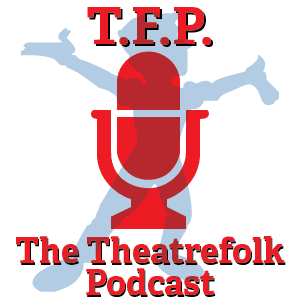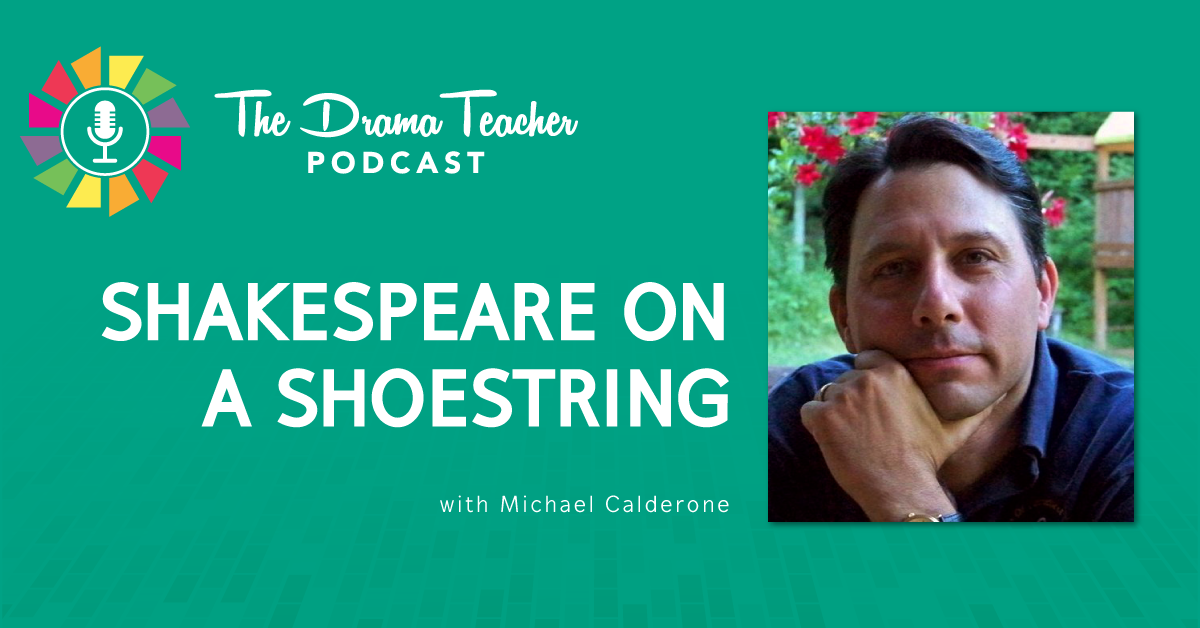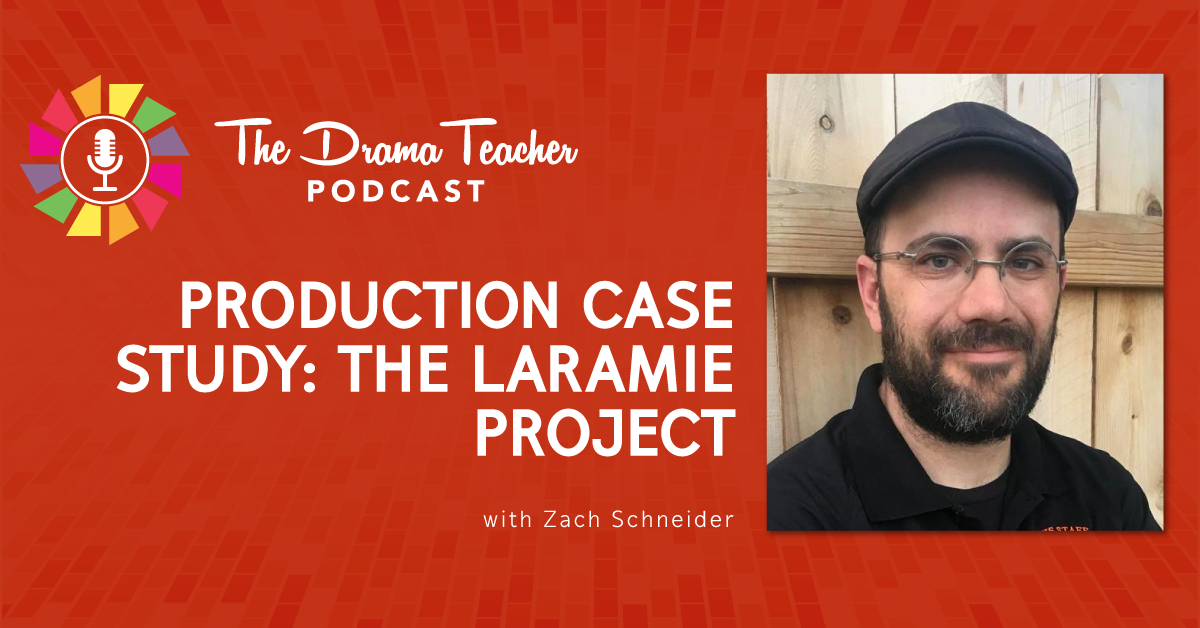Sit Down You’re Rocking the Boat
Episode 8: Sit Down You’re Rocking the Boat
Pull up a chair and join Theatrefolk partners Lindsay Price and Craig Mason in a YouTube Fireside chat. This week we compare three interpretations of “Sit Down You’re Rocking the Boat” from Guys and Dolls – the movie plus two Tony Award Show performances.
Video One – From the 1955 Movie
https://www.youtube.com/watch?v=o7kzsZreG0o
Video Two – From the 1992 Tony Award Telecast
Video Two – From the 2009 Tony Award Telecast
Show Notes:
Subscribe to The Theatrefolk Podcast in iTunes by CLICKING HERE.
Episode Transcript
Welcome to TFP, the Theatrefolk podcast. I am Lindsay Price, the resident playwright for Theatrefolk. Hello, I hope you’re well. Thanks for listening.
Today there is a guest on the podcast, fellow Theatrefolkian Craig Mason for our YouTube Fireside Chat. But first, let’s do THEATREFOLK NEWS. We not only publish plays but we also distribute DVDs from Interactive Educational Video. A fantastic series called Practical Technical Theatre, the complete solution for technical theatre classrooms perfect for teachers who feel more at home with a prompt book than a hammer. Each DVD is essentially, it’s a visual textbook and it comes with Lesson Plans, resource sheets, written assignments, performance rubrics. The series covers everything from set design to lighting to audio to stage management and we are pleased as punch to announce TWO new programs: Careers in Theatre and Costuming for Theatre. Head on over to theatrefolk.com/ptt for more info and learn how you can get a free demo DVD.
Lastly, please always remember and don’t ever forget the places in which you can find this podcast. We post new episodes every Wednesday at theatrefolk.com and our Facebook page and Twitter and you can subscribe to TFP on iTunes. Search for us through Theatrefolk.
Now before we get to the podcast, both Craig and I had an epic fail when we were recording, when we couldn’t recall who had written the music for Guys and Dolls. I just want to rectify that Frank Loesser wrote the music and lyrics.
Episode Eight: YouTube Fireside Chat
Come on in, sit down, and pull up a chair. The fire’s nice and cozy for our YouTube Fireside Chat. This is the TFP episode where myself, Lindsay Price and Craig Mason. We look at, dissect, and talk about some musical theatre clip that we have seen on YouTube. It is one of our favorite activities; Craig plays DJ “Waka! Waka!” and pulls up musical theatre clips for us to enjoy. So Craig, what is the topic of today’s YouTube fireside Chat?
Craig: Sit down, you’re rocking the boat from Guys and Dolls and we really get three different versions.
Lindsay: Yes.
Craig: I’m really excited. We just watched them and took notes, each on our own and I’m so curious to see what you’re going to say and if we agree or if we’re going to have a big fight over this.
Lindsay: Right. So the whole notion of this is the same song and how it gets interpreted. So we have, first of all, we’re going to talk about the movie from 1955 and then we are going to look at the 1992 Tony performance from that year’s Guys and Dolls. And then lastly, the latest production which was in 2009 and I think that we can start off by saying that it’s three pretty different interpretations.
Craig: Yeah. Three, quite widely; two are a little close to each other but three quite wildly different interpretations.
Lindsay: Well and not only that, three different body like just guys, three completely different guys, three different approaches and mostly, funny which I find is really interesting, if there’s a point when he laughs, the guy, the Nicely-Nicely laughs. And we have three completely different laughs so each one chose a different approach.
Craig: Oh, I’m going to pick up on that.
Lindsay: Okay, so Guys and Dolls, which opened on Broadway in 1950. Sit down, you’re rocking the boat is a deep in act new song. And it’s the song where everything is coming to a head. It’s the song where, it’s supposed to show that the gamblers have been reformed so Sky Masterson can get the girl and also to save the mission from being closed for not enough sinners coming in being reformed. So there’s a lot at stake in this song and I think that is an important thing to note. Even though it’s a bit of a frivolous song, there’s something at stake.
Craig: Yeah, well I think what’s great about this song is that a lot of times of musicals in this era, songs are breaks in the action and this is a song that actually tells a narrative. They tells us story and there’s a journey that the characters in the song take from the beginning to the end of the song.
Lindsay: And things change because of this song, right?
Craig: Yes.
Lindsay: They’ve saved the mission and Sky Masterson gets the girl. So there’s an importance. So first we’re going to start off with the movie. The movie was in 1955 and what’s very interesting is that Nicely-Nicely, who is played by Stubby Kaye, awesome name. He also created the role in Broadway which neither of us knew.
Craig: No, we just learned that now. It’s funny about the movie too because I’ve… you see that Frank Sinatra, cause he think well this movie can’t possibly be serious but it is pretty good. Frank Sinatra is pretty good actor. He was great in The Manchurian Candidate. That was the only other thing I’ve seen him in but he was great. I didn’t really see much of him in this video but I’m sure he’s great.
Lindsay: And so what we’ve got in the movie version, so I’ve been talking a lot, so Craig you’re going to first.
Craig: Okay. What I like about this version is that it’s a genuine measured build from the beginning to the end of the song. It start off very introspective, very quiet and through the progress of the song, the gamblers get more and more involved in the story and more and more involved in helping Nicely-Nicely along. One thing I loved about this version is the orchestration. It’s just this gorgeous high fidelity big orchestra sound that must be the exactly what… Who wrote the music Loesser or Low? I can’t remember which one is, which one is which.
Lindsay: Oh we’re terrible people. I don’t know either.
Craig: It’s either Frank Loesser or…
Lindsay: The other guy?
Craig: No. I feel bad. At any right the orchestra sounds amazing and it actually reminds me of listening to records when I was a kid like LPs, that high fidelity sound. I love the music. The other thing I like about this, the gangsters look like gangsters. In this production they do not look like musical theatre performers. And the other thing I’ll say too, for such a big production number, it’s quite amazing how static the camera is. The camera is quite locked in one kind of that upward position for the majority of the song. Anyway I love this version, Lindsay Price.
Lindsay: And I was going to… that’s true, when I was going to dive in on is that particularly when we watched this one first and then the other two. This is clearly a movie version. It’s very locked in a box. For good and for bad I think, the blocking is very much limited to the standing and the sitting of the characters and Nicely-Nicely, he pretty much locks his feet and he doesn’t go anywhere.
Craig: Yeah but there’s also the reality of the situation. They’re in a tiny room too. There’s not much place for them to go.
Lindsay: And I was just about to say, I kind of like that. Because one of the other versions were going to talk about is very… uses, sort of spreads out over the space and I lost the sense of urgency with that spreading out of space and I lost the sense of space. So I actually quite like that it’s very contained and very closed. And they played with the standing and the sitting, there’s a couple of instances of nice use of opposites where everyone is standing, when they’re talking about Sit down, you’re rocking the boat. I find it very simple and close and not overdone.
Craig: Elegant.
Lindsay: Elegant. And what I also liked is because there was that, you couldn’t go anywhere, I really noticed how focused the other con men were on Nicely-Nicely. They were staring at him. And you know, as if their life depended on it which is kind of dead.
Craig: Well it does. This whole play ended to future the next two videos. But, I mean they do not know what Nicely-Nicely is about to say. They do not know how far they should go in agreeing with him. They don’t know, maybe he’ll say something insane, who knows? But they have to follow him and understand where he’s going and sell the same story that he’s selling.
Lindsay: They certainly shouldn’t know and I think that leads quite nicely into 1992 because that’s what I really found at the beginning of this video was there was a really nice sense of panic on the part of the con men when they were like “Okay, somebody walks in. We don’t want to be seen okay. Something is happening here. Okay it’s like a dream. Okay, we’re going to with you on that.” And they go with him. This 1992 version and the person who plays Nicely-Nicely is a gentlemen name Walter Bobbie. And again, we are in a nice close little room. Again, I like that.
Craig: Yeah, I found the clash teams very much more cartoony…
Lindsay: Very, very colorful.
Craig: Yeah. It could just be a Broadway thing. Like it’s so hard to translate theatre on the film but it looks to me like it was way too bright.
Lindsay: And well that’s what and that’s the first thing that I noticed in just in the contrast. We just got more theatre like the movement, instead of when they we’re talking about sailing on that little boat to heaven. In the movie version, it’s literally just shoulders to the right, shoulders to the left. And in this version and certainly in the next version, every actor’s whole entire body is moving forward and moving back in the wings.
Craig: Yeah, the choreography was much more crisp in this version and their lessons in the movie version but the actual storytelling to me felt a bit more labored. Like they we’re really focused on knowing that this is the big number in the show. And really letting us, the audience, know that this is the big number not the big moment in the show but this is the big number. I mean they add on a little bit at the end. It evolves basically into the gym dance from West Side Story like it explodes out of that room and they started running up and down the stage.
Lindsay: I felt that more in the 3rd.
Craig: Yeah, I know it’s more on the 3rd version.
Lindsay: We keep getting more and more focused on the number rather than mistakes.
Craig: So let’s move to the next one.
Lindsay: So let’s move to the next one. The next one which is the 2009 version, this video has a lot of interesting things that happen in it. The gentleman who plays Nicely-Nicely is Tituss Burgess and the first most interesting thing, if that is an English sentence, that we need to talk about is the fact that this was the Tony’s and it was live theatre and the guy’s mike went out.
Craig: Yeah and you can actually hear, at the beginning, you can hear the stage man, staging and deciding whether or not to bring the hand-held mike.
Lindsay: He’s like “Do I go out? Am I going out?” He says “I’m going out”. And he runs onstage… And it was one who, Nicely… the guy playing Nicely-Nicely, he just took the mike. And whatever it is he was supposed to do in terms of choreography, he just did it with the mike and it looks as if it was supposed to be that way on there.
Craig: If you cut out the part with the mike came in, you wouldn’t have known there was anything wrong. I mean that’s what the theatre teaches us to do, right?
Lindsay: Should.
Craig: Theatres basically, a constant management of problems. There’s always something going on in the theatre and you just have to manage what you’re doing. I mean his focus was great and he carried on with the number.
Lindsay: Now the other stuff.
Craig: I like this number the least of the 3.
Lindsay: Me too.
Craig: Okay. There’s a whole bunch of… All the choreography centers basically around the chairs and it’s wonderful like there’s really some neat, cleaver movements. But for me, there’s no storytelling at all because the choreography is the same from the beginning to the end. The singing, the manner in which he is singing is the same from the beginning to the end. He’s huge at the beginning; he’s huge at the end. The gangsters are with him at the beginning, they’re with him at the end. There’s no transition from the beginning to the end for me.
Lindsay: I felt it was all very artificial. I felt the use of the space. So this one, they basically spread out the mission set all the way across the stage. And it is a very wide stage and it just… The use of space made it feel like a stage and not like a closed mission. It felt like there were no stakes, felt that they are… Everybody onstage was dancing and not in the moment.
Craig: Not telling a story. We remember… what we’re always doing whether we’re singing a song, whether we’re doing a monologue or whether they’re doing a scene, whether we’re dancing in a number. We’re always telling a story and if you watch this when there’s no narrative being constructed here. There’s no story being told. You’re seeing an amazing performance. He is an incredible singer. You’re seeing great dancing, great choreography but none of it is serving the greater thing that it should be serving which is the telling of the story. That’s always number one, the telling of the story. There’s no storytelling.
Lindsay: Yeah. There’s no storytelling and it’s…
Craig: And I’ve also believed the end of the song was very disrespectful to the music, to the composers, that in prod section at the end. You know, just a very cheap laugh and completely unnecessary.
Lindsay: That’s exactly what I wrote down, cheap laugh and cheap joke. And it just made me feel that they didn’t understand what was going on, either that or didn’t…
Craig: They were afraid of it.
Lindsay: Or they didn’t respect their audience that the audience couldn’t go along with the stakes of this moment, just all and all a performance not a moment of theatre.
Craig: Yes. Oh I think we agreed on all three of them. So I would rank them in the order that we just discussed them.
Lindsay: Yeah, I think I liked two more than you did. I enjoyed the build and I enjoyed actually, the breaking out of the box. I felt that it suited. The flow from beginning to end, it suited that moment and I didn’t have as much problem with it.
Craig: Yeah, on their set, they’re not really…They’re really using maybe pieces from their set. But on their set, maybe there was a more sensible escape from there, maybe a drop or something that help us transition to the stage proper.
Lindsay: Right, cool. I think what we just really, wrapping up is that great singing and great dancing do not, a show, nick. This is particular to musical theatre where everybody says you know it’s so artificial, why are these people breaking in the song? Why are these people, these news boys dancing? I have to tell you, when we saw the last, maybe that will be the other one. The last Tony’s, it’s just like, these aren’t news boys breaking into a joyful celebration, these are trained dancers.
Craig: Moving in the choreography.
Lindsay: Moving in choreography, I think that’s what I’ll say about the last one is that well there’s somebody… Somebody thinks they’re very clever choreographer.
Craig: They are very cleaver choreographer but not a good storyteller.
Lindsay: I should see that. Alright, Craig Mason, thank you so much for joining me in YouTube.
Craig: It sounds like a business opportunity…
Lindsay: The YouTube Fireside Chat. I love this and I can’t wait for the next one.
Craig: I’m just glad we didn’t fight.
Music credit: “Ave” by Alex (feat. Morusque) is licensed under a Creative Commons license.



